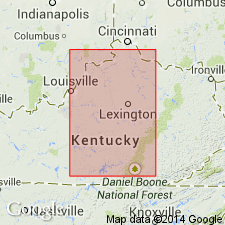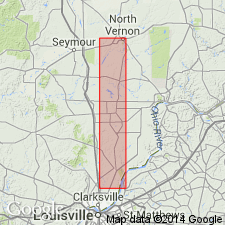
- Usage in publication:
-
- Henryville formation
- Modifications:
-
- Named
- Dominant lithology:
-
- Shale
- AAPG geologic province:
-
- Illinois basin
Summary:
Henryville formation named. Composed of fissile black shale. Never over 1 to 2 ft thick. Conodonts common. Underlain by Underwood formation; overlain by Jacobs Chapel shale.
Source: GNU records (USGS DDS-6; Reston GNULEX).

- Usage in publication:
-
- Henryville Bed
- Modifications:
-
- Revised
- AAPG geologic province:
-
- Illinois basin
Summary:
Henryville formation of Campbell (1946) reduced in rank and assigned as Henryville Bed of Clegg Creek Member of New Albany Shale. Brownish black to black carbon-rich shale, 0.4 to 1.4 ft thick. Underlain by Underwood Bed and overlain by Jacobs Chapel Bed, both of the Clegg Creek Member.
Source: GNU records (USGS DDS-6; Reston GNULEX).

- Usage in publication:
-
- Henryville Bed
- Modifications:
-
- Overview
- AAPG geologic province:
-
- Illinois basin
Summary:
The Falling Run, Henryville, and Jacobs Chapel Beds have been recognized in southeastern IL near the top of the Grassy Creek Shale of the New Albany Shale Group by Cluff and others (1981). In some other areas of IL, the beds overlie greenish-gray shale and are assigned to the undifferentiated Saverton and Hannibal Shales. In IN and west-central KY, these beds are assigned to the Clegg Creek Member of the New Albany Shale. Campbell (1946) mistakenly identified the type locality as Caney Fork Creek. Author here states that actual type is along Lodge Creek, 1.5 mi southwest of Henryville. Bed ranges from 0.4 to 1.7 ft thick in the outcrop area of southeastern IN and reaches a maximum of 4 ft in the subsurface. In one area in southeastern IN, the Henryville overlies the Underwood Bed, a unit of limited extent. In areas of southwestern IN, the three beds become part of the Ellsworth Member of the New Albany.
Source: GNU records (USGS DDS-6; Reston GNULEX).
For more information, please contact Nancy Stamm, Geologic Names Committee Secretary.
Asterisk (*) indicates published by U.S. Geological Survey authors.
"No current usage" (†) implies that a name has been abandoned or has fallen into disuse. Former usage and, if known, replacement name given in parentheses ( ).
Slash (/) indicates name conflicts with nomenclatural guidelines (CSN, 1933; ACSN, 1961, 1970; NACSN, 1983, 2005, 2021). May be explained within brackets ([ ]).

